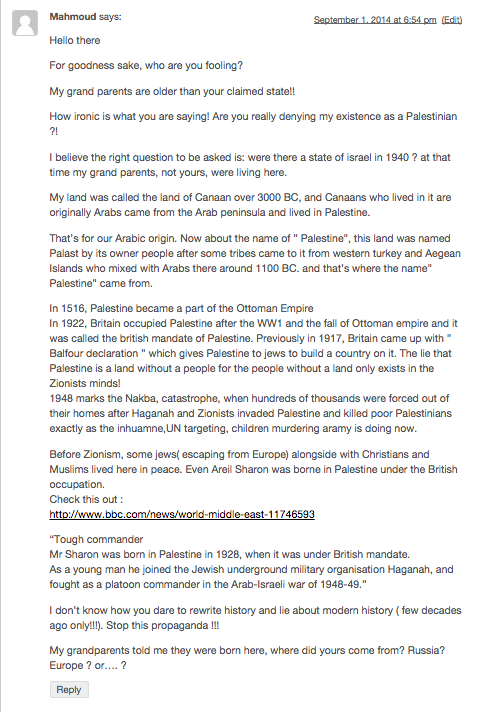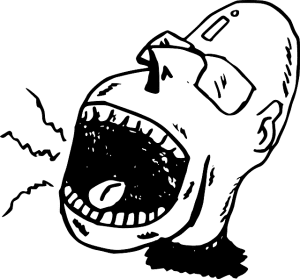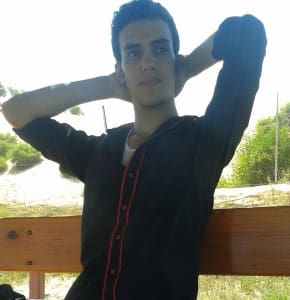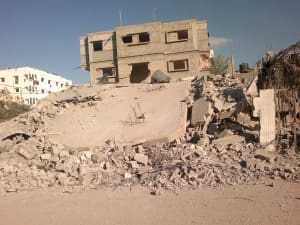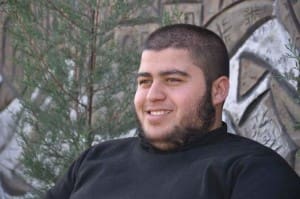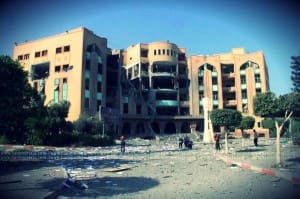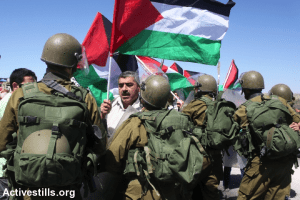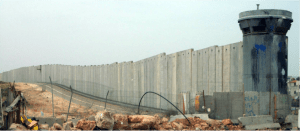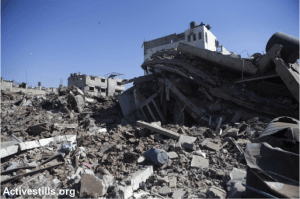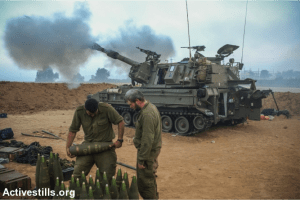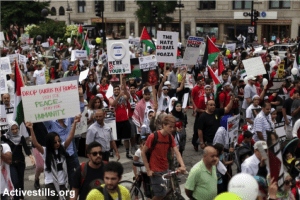In late August, during the attack on Gaza, an Israeli named Guy Hazan left a comment on this blog, A View From My Window in Palestine, in response to a story called, “When the Gaza Sky Burst into Flames.” The story was a guest post written by Mahmoud Khalaf, a friend of mine from Gaza who poured his heart out about his personal experience living through the Israeli bombardment. In response to Mahmoud’s personal story, Guy left this comment:
Mahmoud, a 19-year-old student of English Literature at the Islamic University of Gaza answered so brilliantly, I didn’t even step in. Mahmoud wrote:
Then Guy Hazan commented a second time, and a third time, always in half-thoughts and unclear English. I wrote him an email suggesting that he consolidate his comments and finish making his points or he wouldn’t have impact. It’s not that I liked what he said or that I wanted him to affect my blog readers negatively. But I had no fear that he could convince anyone that Israel was right to rain bombs on 1.8 million people they’d imprisoned. Moreover, I genuinely believe that questions and comments help deepen discussion–whether I agree with them or not. And as they say, for every question (even ones that are hurtful or ignorant), there are tens of other people wondering the same thing. For this reason, I have always tried to respond to comments respectfully and protect my blog as a space for real exchange.
Also, there was a chance that he might really be an Israeli who wanted to engage and understand other views. They do exist.
Guy Hazan answered my email very politely. He thanked me and promptly complied by consolidating his points. His comments became longer and more meaty, but also more confusing. For example, in response to my reply to another reader’s comment (this time on my “about me” page), Guy Hazan wrote:
and he continued:
I apologize for subjecting you to that unintelligible tome, but the gist of it is that Israel is great and Arabs hate Jews. At least that’s what I think he’s saying. I let him off easy for his offensive ideas because he clearly doesn’t express himself well in English.
Soon, Guy Hazan found me on Facebook and I accepted his friend request. Everything I do on Facebook is public anyway, therefore, I tend to accept all friend requests unless they look truly suspicious. Still, I remember feeling a bit discomforted that he’d crossed over from my blog to my Facebook where I am more personal.
For a while, Guy Hazan continued his facade of civility and curiosity as he attacked my knowledge, experience, and credibility, but I was only mildly irritated. He made comments and asked questions, always incorporating misinformation or distortion. At first, I tried to reply with an explanation from my point of view, not for Guy Hazan’s benefit, but for the benefit of others who I knew would be reading the thread. Other Facebook friends of mine also tried to give him another perspective.
But quickly, Guy Hazan was replying to everything I posted, replying to all my comments, even commenting on my friends’ posts (my real friends). He seemed to be on Facebook all day and all night. I felt like he was in the room with me. It occurred to me that he was one of those Israelis paid to attack Palestinians and supporters of Palestinian rights on social media. I looked him up on LinkedIn and found that he was an investment banker in Haifa. I felt the tiniest amount of relief.
Then Guy Hazan started to initiate contact directly with my friends in Gaza. My reaction surprised me, though I didn’t share it publicly. I felt furious and ashamed that I had exposed my friends in Gaza (who are traumatized and deserving of support) to nothing less than harassment and from whom? An Israeli defender of the war! It sounds naïve when I read that back. Of course I know that Facebook is public. I know Israelis read my Facebook. But somehow when Guy Hazan started addressing my friends in Gaza (to whom he had access because of me), I felt violated.
My friends in Gaza held their own. They matched each of Guy Hazan’s comments with historical facts and statistics and quotes and examples. And Guy Hazan got bolder and more offensive. The anger in his comments! The racism!
On September 17 he wrote: “What about the murder of babies in their sleep, With knives, cold-blooded, premeditated? Without regret.” And he posted a link to a video. I didn’t watch it. Before that, there was a back-and-forth exchange with Jason Shawa during which Guy Hazan insisted over and over again that Palestinians hate Jews and Jason insisted over and over again that he didn’t hate Jews. It would have been amusing if it had stopped there.
Now, Guy Hazan seems to be following me full time. In response to everything I share, he puts up links to offensive things. I’m sitting calmly at my computer after a long day, and there’s Guy Hazan’s face flashing across my screen. I feel trapped in a corner. I suspect that’s what he wants. But what’s worse, I’m overwhelmed with concern about what the rest of my friends (my real friends) think about this. People who used to ask questions or express opinions, who sincerely wanted to know my experience, don’t contact me anymore. It’s like Guy Hazan is at my house so no one wants to visit me anymore.
It’s gone beyond Facebook now.
The other day was my daughter’s birthday and she wanted to go to the beach. We went to Herziliya, not far from Haifa where Guy Hazan supposedly works, according to LinkedIn and not far from Nahariya, where Guy Hazan supposedly lives, according to Facebook. I found myself glancing around me to see if Guy Hazan was there. (I am assuming his profile photo is a real photo of him.)
“When you look at these Israelis, do you wonder if they are soldiers and if they’ve done bad things to Palestinians?” I asked the Palestinian who was with me.
“It’s hard not to wonder.”
“And when you look at these little children,” I said, motioning to a particularly adorable toddler girl playing naked in the sand, “do you wonder if they’ll grow up to be soldiers who do bad things to Palestinians?”
“There are all kinds of Israelis. You can’t make assumptions just because they’re Israeli.” (We both knew that was the right answer, but we both knew how hard it is to keep reality from contaminating human relationships.”
I want to be the kind of person who is open. I want to be the kind of person who engages with different points of view. I want to be a person that others can approach with questions that they aren’t comfortable asking elsewhere. And for that reason, I’ve decided to take the bold move to publicly un-friend Guy Hazan and hope that he’ll stop polluting my space. I would have preferred not to have to do that, but I don’t want Guy Hazan in my life anymore. To the extent that Facebook allows, I will try to prevent his offensive commentary from showing up around my friends. I realize that he’ll “spin” this as “not willing to engage in dialogue” and he’ll be partly right. I do not want to engage in dialogue or anything else with Guy Hazan or anyone—Israeli or not—who uses the guise of “dialogue” to attack and harass, insult and hurt.
Bye Guy.

